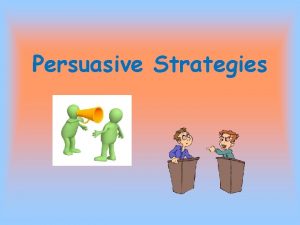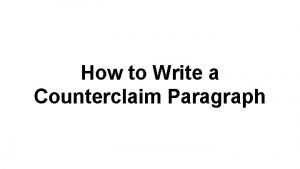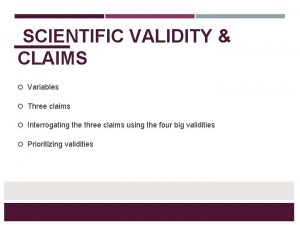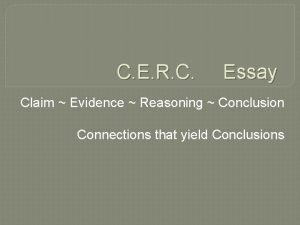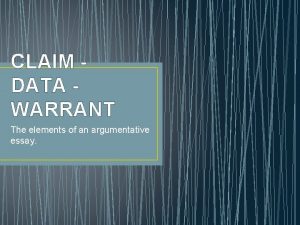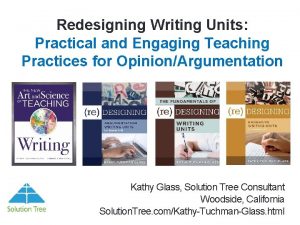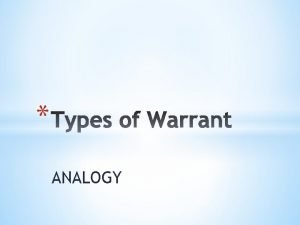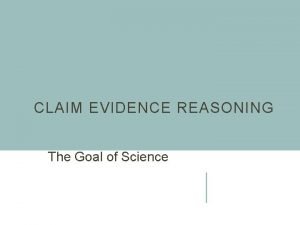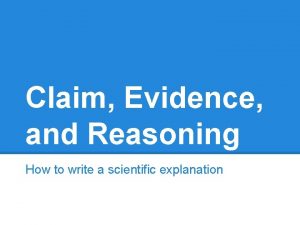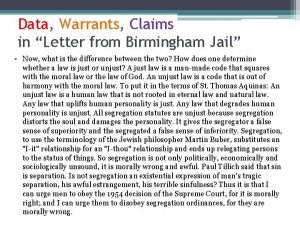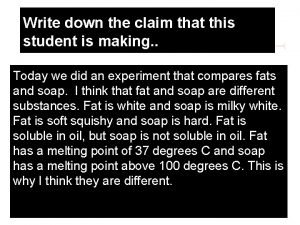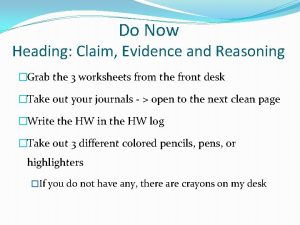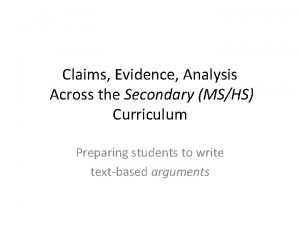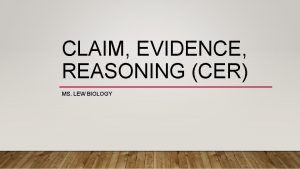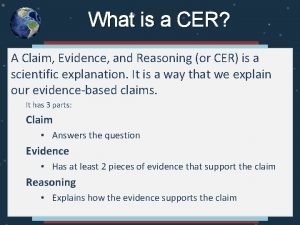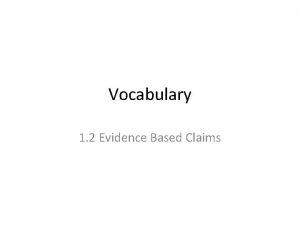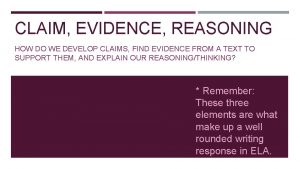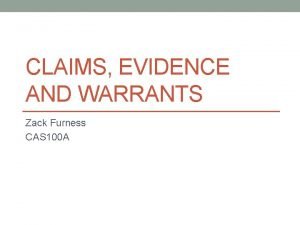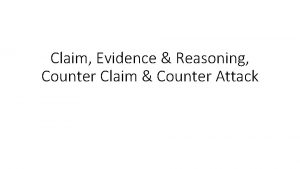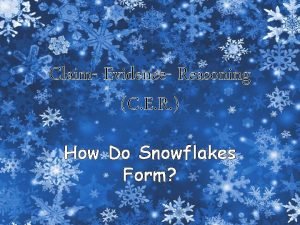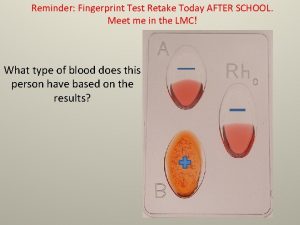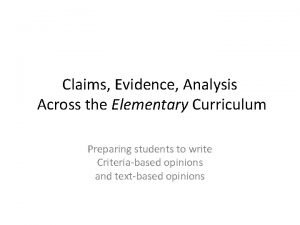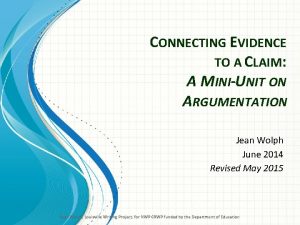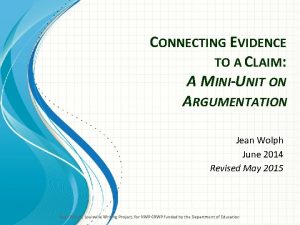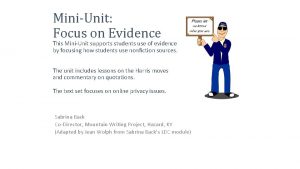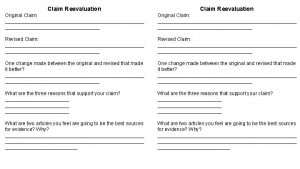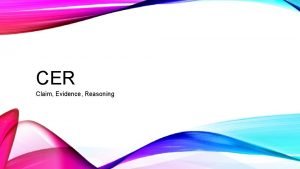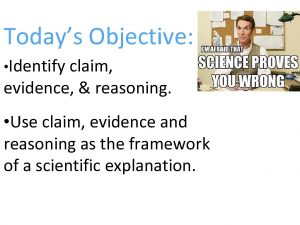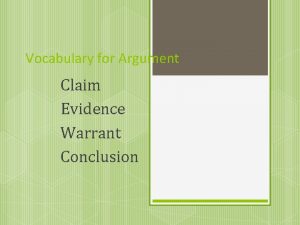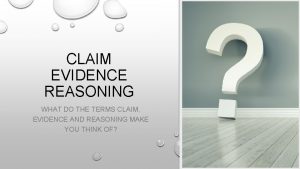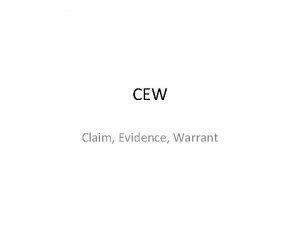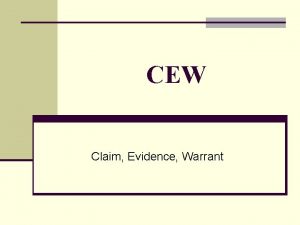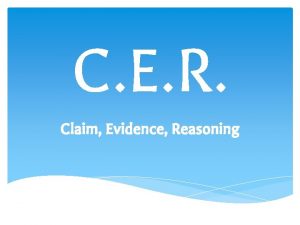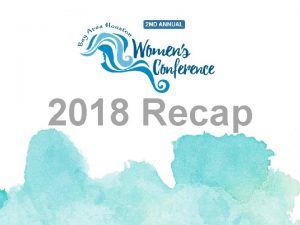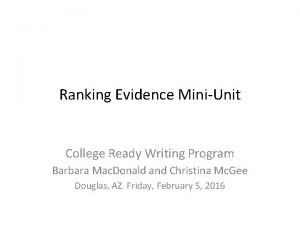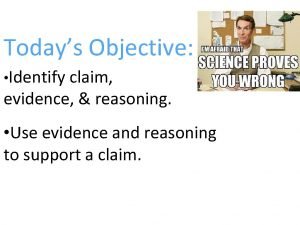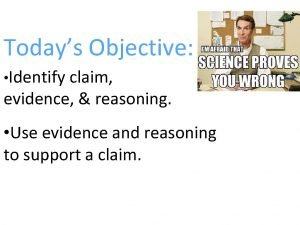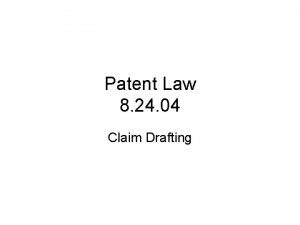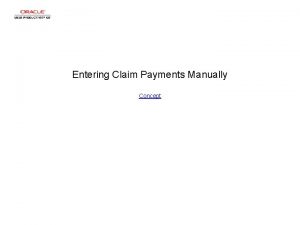CONNECTING EVIDENCE TO A CLAIM A MINIUNIT ON




























- Slides: 28

CONNECTING EVIDENCE TO A CLAIM: A MINI-UNIT ON ARGUMENTATION Jean Wolph June 2014

In this mini-unit, we’ll practice ways that writers use sources to develop their arguments: Illustrating | Use specific examples from the text to support the claim Authorizing | Refer to an “expert” to support the claim Extending | Put your own “spin” on terms and ideas you take from other texts Countering | “Push back” against the text in some way (e. g. , disagree with it, challenge something it says, or interpret it differently)

One problem writers sometimes have is using evidence effectively. Today we’ll focus on connecting our evidence to the claim.

Let’s try an example on a different topic: Claim: Our school should increase its recycling efforts.

Evidence collected so far: Statistics and facts about recycling and about the is arr H h p school’s practices Jocaslels this DING. Next we CONNECT them to our claim. AR W R O F nii m s i In th e’ll look w unit, ially at c espe RATING T ILLUS and DING. N EXTE

? ? ? What will we do when we are… ? ? ? Illustrating: Use specific examples from the text to support the claim Extending: Put your own “spin” on terms and ideas you take from other texts

Source: Waste. Free. Lunches. org Evidence from research (This is the evidence that we will use or forward, to advance our argument. ) “Lunch foods cause a big trash problem. In fact, on average a school-age child using a disposable lunch generates 67 pounds of waste per school year. That equals 18, 760 pounds of lunch waste for just one averagesize elementary school. ” A waste-free lunch could save $246. 60 per school year person. Claim: Our school should increase its recycling efforts. How could we connect this piece of evidence to our purpose, to convince readers that we should increase our recycling efforts? f ces o e i p These ce will n evide d or e be us ded to r forwa RATE T ILLUS r claim ou why od one. o is a g

Source: Waste. Free. Lunches. org Evidence from research (What we will forward, to advance our argument. ) “Lunch foods cause a big trash problem. In fact, on average a school-age child using a disposable lunch generates 67 pounds of waste per school year. That equals 18, 760 pounds of lunch waste for just one averagesize elementary school. ” A waste-free lunch could save $246. 60 per school year person. Connection to claim: Our school should increase its recycling efforts. (This is where we’ll extend the evidence, putting our own spin on it. ) Students at our school often bring disposable containers in their sack lunches. Encouraging everyone to use washable containers instead would reduce the amount we throw this s l l a c e away each day. Harris g becaus din exten oving m we’re the d e beyon ation we’v inform cited.

Source: T. Pragya, “Recycling Facts for Kids” Evidence from research Claim: Our school should increase its recycling efforts. (what we will forward to advance (how we’ll extend the evidence, putting our own spin on it. ) our argument. ) ting tra Illus Families throw How could we connect the away 6 trees of evidence to our purpose, to paper in a year. convince readers that we should increase our recycling efforts ?

Source: T. Pragya, “Recycling Facts for Kids” Evidence from Connection to claim: Our school should increase its recycling efforts. research g Ill tin a r t us (what we will forward) (how we’ll extend the evidence) Families throw away 6 trees of paper in a year. Some of the paper we use at school is sent home in the form of notes and newsletters. We could reduce the number of notes home by posting most notices on our website instead. ng ndi e t x E

Source: T. Pragya, “Recycling Facts for Kids” Evidence from research ting tra Illus (what we will forward) We use 4 million plastic bottles an hour. The average person uses 107 bottles and 160 cans a year. “Reusing saves landfill space. We are running out of places to bury our trash. ” Claim: Our school should increase its recycling efforts. (how we’ll extend the evidence) How could we connect the evidence to our purpose, to convince readers that we should increase our recycling efforts?

Source: T. Pragya, “Recycling Facts for Kids” Evidence from Connection to claim: Our school should increase its recycling efforts. research We use 4 million plastic bottles an hour. ting The average person tra Illus uses 107 bottles and 160 cans a year. “Reusing saves landfill space. We are running out of places to bury our trash. ” Preparing cafeteria lunches for students means a large number of bottles and cans are emptied each day. We could reduce the amount of trash sent to the landfill if we recycled them instead. ng ndi e t x E

How can we explain the process we just used? How will we apply it to our own research and writing in order to make a stronger connection between our evidence and our claim?

Next Steps: Return to our text set on Fast Food. Use the Chart to Column 1 • Organize the key facts and stats you plan to use Column 2 • Explain how/why those facts are relevant to your claim

Source: Evidence from Claim: research Connection to Claim: Illustrating Extending

FEEDBACK How well did we connect our evidence to our claims? How well did we use the facts for our own purposes (support our claim)?

Use your chart to flesh out a flashdraft of the argument.

SOMETIMES WE DISCOVER WE NEED MORE INFORMATION IN ORDER TO EFFECTIVELY CONNECT THE EVIDENCE TO OUR CLAIM. PERSONALIZING THE DATA CAN HELP.

Digging Deeper / Honing our Skills How might we personalize our evidence in order to make an even stronger connection to our claim?

Example: ng Illu ti a r t s Evidence: “Lunch foods cause a big trash problem. In fact, on average a school-age child using a disposable lunch generates 67 pounds of waste per school year. ” How could I find out how many of our students and teachers bring disposable lunches? I could make a count and then calculate an average. Or I could conduct a survey to see how often students bring their lunches. I could also ask if anyone already uses only ng washable containers. endi Ext

Our own survey helps us improve our connection to the claim: Source: http: //www. recyclenow. com/recycle-school/get-your-recyclingcollected/how-much-does-your-school-waste. Evidence: Connection: “Lunch foods cause a big trash problem. In fact, on average a school-age child using a disposable lunch generates 67 pounds of waste per school year. ” • Our survey shows 39% of our students bring their lunches from home most days. • 67 pounds of waste x 233 students = 6088 pounds. • 6000 lbs. = 3 tons. g ndin Exte

Next, let’s draft what we could say about this personalized evidence. Source: http: //www. recyclenow. com/recycle-school/get-your-recyclingcollected/how-much-does-your-school-waste. Evidence: Connection: “Lunch foods cause a big trash problem. In fact, on average a school-age child using a disposable lunch generates 67 pounds of waste per school year. ” A school-wide survey showed that 39% of our students bring their lunches from home on a regular basis. At 67 pounds of waste per student, we could be keeping about 3 tons of refuse out of the landfill, just by putting our food in washable containers instead of buying food in disposable packs. g n ndi e t x E

Another Example: Evidence: Initial Connection: “Recycling a ton of paper saves 17 trees. ” Middle school students and teachers use a lot of paper each day. Much of this ends up in the trash. Attention to recycling could reduce the number of trees that are sacrificed. ng i d n e ting tra Illus Ext Hmm…I don’t know how much paper our students and teachers throw away. I could conduct a waste audit so that this statistic would have more meaning. Or I could look for statistics that estimate how much students waste. ng di n e t Ex

Another statistic (our school’s size) helps us improve our connection to the claim: Source: http: //www. recyclenow. com/recycle-school/get-your-recyclingcollected/how-much-does-your-school-waste. Evidence: Connection: “The average secondary school produces 22 kg of [paper] waste per pupil each academic year. ” ng ndi e t x E • We have 223 students. • 22 kg per student x 233 = 5, 126 kg of wasted paper • Can we visualize metric measurements? If not, let’s convert: 48 lbs. per student or 11, 300 pounds …. . (nearly 6 tons!).

We can now take our original piece of evidence further: “Recycling a ton of paper saves 17 trees. ” Wow! If our school produces nearly 6 tons of paper trash each year, we could be saving 102 trees annually!!!! ing nd e t x E

Putting the connection into words is the next step: Source: http: //www. recyclenow. com/recycle-school/get-your-recyclingcollected/how-much-does-your-school-waste. Evidence: Connection: “The average secondary school produces 22 kg of [paper] waste per pupil each academic year. ” While a waste audit would help us know exactly how much our school is throwing away, we can use the average of 22 kg per student to estimate that our school sends 5, 126 kg of paper to the landfill each year. That’s 48 lbs. per student or 11, 300 pounds (nearly 6 tons!) from our school of 233 students. We could save over 100 trees each ing year just by recycling. tend EX

Next Steps: Extending! Column 1 • Return to the key facts and stats you plan to use. Column 2 • Review your explanations of how/why those facts are relevant to your claim. Column 3 • Personalize! Plan additional datagathering as needed to closely connect the evidence to the claim. Then revise your original flashdraft to include the new, personalized evidence.

Source: Evidence from Claim: research Connection to Claim: Illustrating MY KEY FACTS Extending How I’ve made these key facts relevant to my claim s on o e t no od t h t i d w ee n © I t i h t. Pos esearc urther acts. r f f the der to these r in o onalize s per
 Claim of fact
Claim of fact Counterclaim
Counterclaim Example of a counterclaim paragraph
Example of a counterclaim paragraph Four big validities
Four big validities Cerc paragraph
Cerc paragraph Claim evidence warrant paragraph example
Claim evidence warrant paragraph example Claim reason evidence example
Claim reason evidence example Argument by analogy
Argument by analogy Reasoning vs evidence
Reasoning vs evidence Mr xavier mystery claim evidence reasoning
Mr xavier mystery claim evidence reasoning Birmingham city jail warrants
Birmingham city jail warrants What caused the death of mr xavier answer
What caused the death of mr xavier answer Queenie volupides answer
Queenie volupides answer Claim evidence analysis
Claim evidence analysis Slip or trip claim evidence reasoning answers
Slip or trip claim evidence reasoning answers Examples of cer
Examples of cer Claim defintion
Claim defintion Mr xavier mystery claim evidence reasoning
Mr xavier mystery claim evidence reasoning Evidence and claim examples
Evidence and claim examples Claim evidence reasoning counterclaim
Claim evidence reasoning counterclaim What is a reasoning in a cer
What is a reasoning in a cer Claim evidence impact
Claim evidence impact Claim evidence reasoning sentence starters
Claim evidence reasoning sentence starters Claim evidence and commentary
Claim evidence and commentary Claim evidence analysis
Claim evidence analysis Primary evidence vs secondary evidence
Primary evidence vs secondary evidence Primary evidence vs secondary evidence
Primary evidence vs secondary evidence Explain how class evidence may be useful.
Explain how class evidence may be useful. Primary evidence vs secondary evidence
Primary evidence vs secondary evidence

